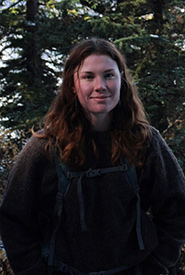Weeding out trouble: A summer as an invasive species sleuth
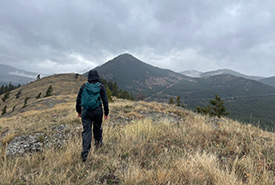
Hiking on the ridge to check on biocontrol releases (Photo by NCC)
This summer I had the incredible opportunity to work as an invasive species technician with the Nature Conservancy of Canada (NCC) in the Waterton and Castle Crowsnest Natural Area. This remarkable area is known for its diverse landscapes and habitats, like intact montane forests, vast grasslands, rugged alpine tundra and riparian zones. Situated in the Crown of the Continent, corridors here serve as critical migration routes and pathways for wildlife. It really is such a special place!
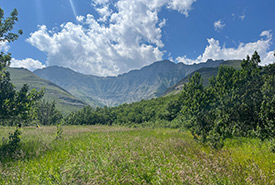
A hike into Blind Canyon to pull common burdock (Photo by Ayla Peacock/NCC)
My internship revolved around the relentless fight against a significant but often overlooked opponent: invasive weeds. Invasive species rank among the top five threats to biodiversity, so while not always glamorous work, it is an incredibly important part of conservation. Twenty-five provincially regulated invasive species have been identified on NCC properties in the area, each requiring a tailored strategy for effective control.
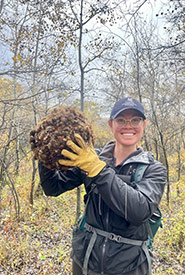
A big gall of burdock burrs that I pulled, clumped together, and then bagged. (Photo by Ayla Peacock/NCC)
The proliferation of weeds in this region can largely be attributed to historical resource extraction activities and the substantial amount of human traffic. The landscape here has borne witness to forestry, oil and gas, and mining operations for over a century now, paving the way for plenty of invasive species to establish. While natural forces such as wind or animal dispersal play a role in the spread of invasive species, their spread is accelerated when seeds can hitchhike on vehicles and road maintenance equipment along major highways.
A (not so) fun fact: one of my least favourite weeds that we deal with regularly served as the inspiration for Velcro — those common burdock burrs cling to clothing relentlessly! This is why it is so important to inspect and clean your shoes, clothes and gear before transitioning from one area to another. Each of us plays a crucial role in curbing the spread of invasive species!
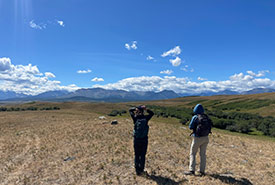
Technicians mapping invasive weeds in Waterton Park Front, AB. (Photo by NCC)
Before we can control the weeds, we must know where they are. Luckily, this field season we were able to get right to it as a large portion of last year’s field season was spent mapping these invasive weeds on NCC properties. However, our eyes are still always peeled because new patches can pop up in what seems like the blink of an eye. Working as an invasive species technician quickly trained my eye for weeds and now, I detect them everywhere I go, whether I am at work or not. It’s a double-edged sword, making me an efficient technician while simultaneously causing me to realize the pervasiveness of invasive species when I’m out exploring nature! However, this heightened awareness also fosters in me a deep appreciation for native, well-stewarded land. Invasive species should make all of us uncomfortable, as that is what fuels the drive for change.
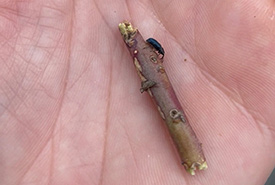
Stem-boring weevil on a Dalmatian toadflax stem (Photo by Cameron McArthur/NCC)
Approaching weed control with an integrated pest management plan is essential. This means using different tools depending on the situation and target species. These tools include herbicides, physical removal and biological controls, which is the use of living organisms to control invasives.
Using biological controls is interesting and challenging work. This summer I had the opportunity to collect stem-boring weevils, which eat away at one of the worst invasive species in southeast Alberta, Dalmatian toadflax. We hiked them up onto a ridge in hopes of achieving controlling a toadflax population up there. I’ve never poured so much faith into bugs! Many other days were spent hiking into beautiful landscapes to spot spray herbicides with backpacks or hand pull weeds.
While my time as an invasive species technician wraps up here at NCC, my battle against invasive weeds in Alberta is far from over. I plan to volunteer at many more local weed pulls, and you should too!
NCC’s Internship Program in Alberta is supported by United Nations Association in Canada’s Science and Technology Internship Programme.

